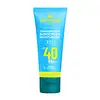What's inside
What's inside
 Key Ingredients
Key Ingredients

 Benefits
Benefits

 Concerns
Concerns

 Ingredients Side-by-side
Ingredients Side-by-side

Water
Skin ConditioningDibutyl Adipate
EmollientPropanediol
SolventDiethylamino Hydroxybenzoyl Hexyl Benzoate
UV FilterPolymethylsilsesquioxane
Ethylhexyl Triazone
UV AbsorberMethylene Bis-Benzotriazolyl Tetramethylbutylphenol
UV FilterNiacinamide
SmoothingCoco-Caprylate/Caprate
EmollientCaprylyl Methicone
Skin ConditioningDiethylhexyl Butamido Triazone
UV AbsorberGlycerin
Humectant1,2-Hexanediol
Skin ConditioningButylene Glycol
HumectantPentylene Glycol
Skin ConditioningBehenyl Alcohol
EmollientPoly C10-30 Alkyl Acrylate
Emulsion StabilisingPolyglyceryl-3 Methylglucose Distearate
EmulsifyingDecyl Glucoside
CleansingTromethamine
BufferingCarbomer
Emulsion StabilisingAcrylates/C10-30 Alkyl Acrylate Crosspolymer
Emulsion StabilisingSodium Stearoyl Glutamate
CleansingPolyacrylate Crosspolymer-6
Emulsion StabilisingEthylhexylglycerin
Skin ConditioningAdenosine
Skin ConditioningXanthan Gum
EmulsifyingCentella Asiatica Extract
CleansingT-Butyl Alcohol
PerfumingSodium Hyaluronate
HumectantBetula Platyphylla Japonica Bark Extract
Skin ConditioningTocopherol
AntioxidantHydrolyzed Hyaluronic Acid
HumectantCamellia Sinensis Leaf Extract
AntimicrobialGinkgo Biloba Leaf Extract
Skin ConditioningBrassica Oleracea Italica Sprout Extract
EmollientCamellia Japonica Leaf Extract
Skin ConditioningEruca Sativa Leaf Extract
Skin ConditioningMedicago Sativa Extract
TonicTriticum Vulgare Sprout Extract
Skin ConditioningInositol
HumectantHyaluronic Acid
HumectantWater, Dibutyl Adipate, Propanediol, Diethylamino Hydroxybenzoyl Hexyl Benzoate, Polymethylsilsesquioxane, Ethylhexyl Triazone, Methylene Bis-Benzotriazolyl Tetramethylbutylphenol, Niacinamide, Coco-Caprylate/Caprate, Caprylyl Methicone, Diethylhexyl Butamido Triazone, Glycerin, 1,2-Hexanediol, Butylene Glycol, Pentylene Glycol, Behenyl Alcohol, Poly C10-30 Alkyl Acrylate, Polyglyceryl-3 Methylglucose Distearate, Decyl Glucoside, Tromethamine, Carbomer, Acrylates/C10-30 Alkyl Acrylate Crosspolymer, Sodium Stearoyl Glutamate, Polyacrylate Crosspolymer-6, Ethylhexylglycerin, Adenosine, Xanthan Gum, Centella Asiatica Extract, T-Butyl Alcohol, Sodium Hyaluronate, Betula Platyphylla Japonica Bark Extract, Tocopherol, Hydrolyzed Hyaluronic Acid, Camellia Sinensis Leaf Extract, Ginkgo Biloba Leaf Extract, Brassica Oleracea Italica Sprout Extract, Camellia Japonica Leaf Extract, Eruca Sativa Leaf Extract, Medicago Sativa Extract, Triticum Vulgare Sprout Extract, Inositol, Hyaluronic Acid
Water
Skin ConditioningGlycerin
HumectantCyclopentasiloxane
EmollientPhenylbenzimidazole Sulfonic Acid
UV AbsorberTromethamine
BufferingDimethicone
EmollientTerephthalylidene Dicamphor Sulfonic Acid
UV AbsorberPEG/PPG-17/6 Copolymer
SolventHelianthus Annuus Seed Oil
EmollientRosmarinus Officinalis Leaf Extract
AntimicrobialPrunus Persica Flower Extract
MoisturisingHexylene Glycol
EmulsifyingHydroxyacetophenone
AntioxidantPEG-10 Dimethicone
Skin ConditioningParfum
MaskingDipropylene Glycol
HumectantSodium Citrate
BufferingSodium Benzoate
MaskingCitric Acid
BufferingTocopherol
AntioxidantEthyl Ferulate
AntioxidantCaprylyl Methicone
Skin ConditioningDimethicone/Vinyl Dimethicone Crosspolymer
Skin ConditioningWater, Glycerin, Cyclopentasiloxane, Phenylbenzimidazole Sulfonic Acid, Tromethamine, Dimethicone, Terephthalylidene Dicamphor Sulfonic Acid, PEG/PPG-17/6 Copolymer, Helianthus Annuus Seed Oil, Rosmarinus Officinalis Leaf Extract, Prunus Persica Flower Extract, Hexylene Glycol, Hydroxyacetophenone, PEG-10 Dimethicone, Parfum, Dipropylene Glycol, Sodium Citrate, Sodium Benzoate, Citric Acid, Tocopherol, Ethyl Ferulate, Caprylyl Methicone, Dimethicone/Vinyl Dimethicone Crosspolymer
 Reviews
Reviews

Ingredients Explained
These ingredients are found in both products.
Ingredients higher up in an ingredient list are typically present in a larger amount.
Caprylyl Methicone is a type of silicone.
It helps soften and soothe the skin by creating a thin film on top. This film helps trap moisture, keeping your skin hydrated.
Glycerin is already naturally found in your skin. It helps moisturize and protect your skin.
A study from 2016 found glycerin to be more effective as a humectant than AHAs and hyaluronic acid.
As a humectant, it helps the skin stay hydrated by pulling moisture to your skin. The low molecular weight of glycerin allows it to pull moisture into the deeper layers of your skin.
Hydrated skin improves your skin barrier; Your skin barrier helps protect against irritants and bacteria.
Glycerin has also been found to have antimicrobial and antiviral properties. Due to these properties, glycerin is often used in wound and burn treatments.
In cosmetics, glycerin is usually derived from plants such as soybean or palm. However, it can also be sourced from animals, such as tallow or animal fat.
This ingredient is organic, colorless, odorless, and non-toxic.
Glycerin is the name for this ingredient in American English. British English uses Glycerol/Glycerine.
Learn more about GlycerinTocopherol (also known as Vitamin E) is a common antioxidant used to help protect the skin from free-radicals and strengthen the skin barrier. It's also fat soluble - this means our skin is great at absorbing it.
Vitamin E also helps keep your natural skin lipids healthy. Your lipid skin barrier naturally consists of lipids, ceramides, and fatty acids. Vitamin E offers extra protection for your skin’s lipid barrier, keeping your skin healthy and nourished.
Another benefit is a bit of UV protection. Vitamin E helps reduce the damage caused by UVB rays. (It should not replace your sunscreen). Combining it with Vitamin C can decrease sunburned cells and hyperpigmentation after UV exposure.
You might have noticed Vitamin E + C often paired together. This is because it is great at stabilizing Vitamin C. Using the two together helps increase the effectiveness of both ingredients.
There are often claims that Vitamin E can reduce/prevent scarring, but these claims haven't been confirmed by scientific research.
Learn more about TocopherolTromethamine helps balance the pH and improve the texture of a product. It is synthetically created.
As an emulsifier, Tromethamine prevents oil and water ingredients from separating. This helps stabilize the product and elongate a product's shelf life. Tromethamine also makes a product thicker.
Tromethamine helps balance the pH level of a product. Normal pH level of skin is slightly acidic (~4.75-5.5). The acidity of our skin is maintained by our glands and skin biome. Being slightly acidic allows our skin to create an "acid mantle". This acid mantle is a thin barrier that protects our skin from bacteria and contaminants.
Oral Tromethanmine is an anti-inflammatory drug but plays the role of masking, adding fragrance, and/or balancing pH in skincare.
1,3-Propanediol, 2-amino-2-(hydroxymethyl)-
Learn more about TromethamineWater. It's the most common cosmetic ingredient of all. You'll usually see it at the top of ingredient lists, meaning that it makes up the largest part of the product.
So why is it so popular? Water most often acts as a solvent - this means that it helps dissolve other ingredients into the formulation.
You'll also recognize water as that liquid we all need to stay alive. If you see this, drink a glass of water. Stay hydrated!
Learn more about Water